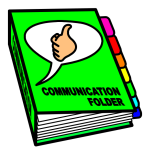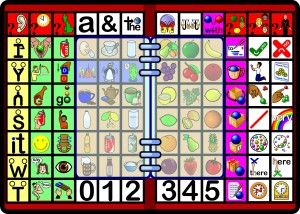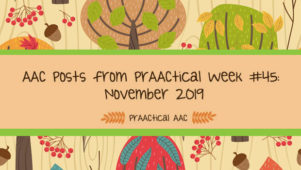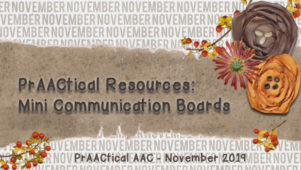The PrAACtical Power of Communication Books

There’s something about the month of December that makes us a bit nostalgic. As we prepare for the holidays, our thoughts drift to the past. Simpler times. Tradition. The way things used to be. And, so, for our Strategy of the Month, we step away from the latest app or fanciest SGD and turn our attention to one of the tried-and-true tools from the past: Communication books.
They used to be ubiquitous but now they’re becoming almost a rarity. We’ve decided to focus on them for a couple of reasons, but the main one is to spread the word that it doesn’t take a sizeable budget to give someone access to real language. If you have access to a computer and printer, you can make a really robust communication book for little or no money.
It seems so simple: Put some words and pictures in a book. Show someone how to use it and begin talking. In actuality, it’s more complicated, but certainly not rocket science. With a good amount of focus and a few hours of time, any SLP can create well-designed communication books and begin teaching his/her clients how to use them.
The most important part of making a communication book is the thinking we do before we begin. Like a set of architectural plans for a building or a schematic for a machine or a storyboard for a film, the project ‘makes it or breaks it’ in the planning stage. Give yourself some time and space to think things through before you start.
Here is the main question that we try to ask ourselves as we get started: What’s the real purpose of the communication book? Specificity matters here because the goal is to create something that is well-suited to the need. We don’t want a factory built on a beach or a beach house in an industrial park. Knowing what you want to accomplish with the book is critical to making one that really works. When we fail to give some real thought to this stage, we end up with books that have only a small chance of meeting the communicator’s needs. We end up with books that don’t get used or get used but don’t contribute to meaningful gains in communication skills.
Pitfalls to Avoid
- Noun-heavy Content: In some communication books, 75% of the content is made up of nouns, like foods, body parts, and toys. This
 works well for kids whose primary goals are for requesting, labeling, and list making. Conversation? Language learning? Not so much.
works well for kids whose primary goals are for requesting, labeling, and list making. Conversation? Language learning? Not so much. - Hard to Use: You have to go to 3 different pages to say a simple sentence. That may work if you are already good at sentence building AND it’s easy for you to turn to the right page. Otherwise, it can be a tedious and frustrating process that discourages the development of syntax and longer utterances.
- Non-Conversational Content: There isn’t much to talk about in some communication books. The messages in the book don’t allow the user to say much of anything that anyone would want to talk about. Some books don’t have much use beyond requesting. We’ve all known people who only call or show up when they want something. They’re not much fun to be with. Shouldn’t we be enabling AAC learners to be more balanced communicators?
Luckily, those pitfalls aren’t that difficult to avoid in creating a well-designed communication book. Again, the key is in the preparation. Here are some things that we try to focus on during the planning stage.
- Know the specific purpose for the book: A book that is communicator’s primary means of expression 24/7, will be very different than one designed to support the communicator at mealtime, in an art activity, or on a trip to the library.
- Think about the implications that the purpose has on the book’s vocabulary and organization. If you want an AAC learner to use it for conversation and social interaction, then the messages have to reflect that. Consider: Greetings, introducing topics, talking about the topic, adding new information, asking partner-focused questions, re-directing, clarifying, affirming, disagreeing, terminating the interaction, etc.

- Core vocabulary: If you are trying to use the book to teach real language skills, then the AAC learner has to have a robust base of core words. Period. Using anything less may allow our AAC learners to function but will not allow them to grow their language skills.
- Keep an eye on the future. If you want the communicator to develop new skills, you have to design the book with that in mind. If the book only has things that the AAC user can say right now, we’re limiting opportunities for growth. Think about where you want the communicator to be because chances are you’ll also use the book for aided language input. I think of it like buying shoes for a 10 year old. If you get the exact fit, he’ll need new ones in two months so we want to choose those that have a little growing room. On the other hand, if you get them too large he’ll trip and that’s not good either. So, we would advocate for a book that has a little room to grow but not so much of a stretch that the AAC learner gets overwhelmed.
- Accept that the book will have limitations and plan accordingly. There is only so much space to work with, so options for vocabulary are limited. One surefire way to lessen the detrimental effect of that is to provide a way to tell someone let you know that he/she has no way to express a particular thought. Consider messages like: “It’s not here.” “I have something to tell you, but it’s not in this book.”
- Make it appealing. Everyone deserves tools that are nice to look at. Plus, we all tend to like and USE the things that are pleasing to the eye. Look around at the artifacts in your own life. How well do you take care of things that are messy or sloppy? How often do you use or wear the things that are ugly or boring? Having pretty, cute, or chic things is not something that should have to be earned by having a certain IQ or skill set.
- Make it personal. The communication book should reflect the user’s personality and interests, both in the contents (vocabulary, messages) and appearance (cover, style, colors). There is a natural tendency to make better use of things that are a good reflection of who we are. Check your closet if you’re not sure about that. Chances are that you have at least one thing that fits just fine, but doesn’t get worn much because it just isn’t ‘you.’ If we want augmentative communicators to really use the tools that we create, it makes sense to personalize them to the individual for whom they are designed.
- Try it out. If you can’t have a decent conversation with the communication book, chances are that the AAC learner won’t have any better luck. Every time that I stop and use a book myself, I gain some insight into how to make it better. I may not be able to drop everything and fix it right then and there, but at least I can store the information away so that I can make adjustments as time allows.
- Teach how to use it. What seems intuitive to us is foreign to most people with AAC needs and they need solid instruction in order to become effective communicators. Communication books are just tools and tools don’t accomplish much in the hands of an inexperienced user. Effective communication doesn’t come from osmosis, but rather emerges bit by bit when learners are provided with good, persistent intervention.
With apologies to Nike, our final piece of advice is this: Just do it. The guidelines and options can seem overwhelming if you are new to making AAC materials. Our advice? Don’t be intimidated by not being an expert. Don’t get paralyzed with anxiety or the fear of not doing it right. No one ever died from a less-than-perfect communication book, so give yourself the freedom to roll up your sleeves and make a start. You can always modify it or replace it when better ideas come along. Our guess is that many more people are harmed from not having a communication book at all than from having one that needs some improvements.
Throughout the month, we’ll talk more about some of the things we think about as we make these AAC materials, modify those that we’ve already made, or start to teach someone how to use communication books. In the meantime, we’ll leave you with some inspiring examples. There are some mighty fine clinicians out there and we celebrate them.
- SET-BC’s 15-page starter book that fits into a small notebook
- Trifold book by Marcia Sterner on Boardmaker Share
- Large and small notebooks from Baltimore County Public Schools
Filed under: Strategy of the Month
Tagged With: communication book
This post was written by Carole Zangari





8 Comments
Great post – thanks Carole. Another really good one I can refer people to – I love the way you guys keep creating all these awesome resources for ALL of us to use!
Thanks, Jane! I think it’s great that those of us who have been doing this awhile have been reaching out to those who are getting started in the process. That’s what it’s all about, right?
This is a great post! I think I am going to try to replicate your core board for the AT center. It looks like you are using Pixon symbols for some items. What symbol set are the pronouns from?
Celeste, the images in this post were given to use by TalkSense. 🙂
Thanks Carole! I just sent them an email.
Great! 🙂
Hi Carole.
Do you (or anyone) have a suggestion of how to attach a communication book to a wheelchair or arm tray for a patient who is hemiplegic? I’ve made countless AAC systems for her, but it comes down to the fact that keeping it on her person and accessing it with only 1 arm is just too difficult to be functional. Ideas? Thanks!
Valerie, depending on what the specific challenge is there are a couple of things to try. If the issue is turning pages b/c of issues crossing midline, I tend to bind the book in such a way so that the tabs are on the dominant side and pages turn from bottom to top (rather than left to right). If the issue is not being able to stabilize it, I’ve put non-slip surface (like Dycem or dollar store shelf liner) on the back/bottom cover to reduce slippage. For keeping it handy, a cross-body strap has worked for some but I’ve also had a few where attaching a Command hook to the side of a chair/tray worked even better (easy to retrieve). Custom ChatBags can be helpful for more challenging situations (http://www.chatbag.net/catalog.php?category=31). Hope that helps with some ideas. 🙂 These are tricky problems that are essential to deal with for any real functionality. Good luck!